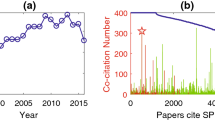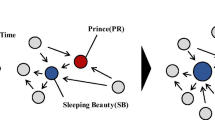Abstract
‘Sleeping beauties’ refer to the papers that received no or scarce citation after appearance, but considerable citations several years later, which is a special citation pattern. Following two new citation models called ‘black–white swans’ and ‘swan-groups’ that described interactional citation phenomena in the key publications of Nobel laureates, we find that there are ‘associated-sleeping-beauties’ in ‘swan-groups’ in the field of physics and economics, which means that the phenomena are established in both science and social science. In practical datasets 1995–2010, there are 12% and 11% ‘associated-sleeping-beauties’ in ‘swan-groups’ of physics and economics, respectively. Moreover, we extend data in discipline of medicine to do further validation, and 2 ‘associated-sleeping-beauties’ are discovered.









Similar content being viewed by others
References
Bornmann, L., & Marx, W. (2015). Methods for the generation of normalized citation impact scores in bibliometrics: Which method best reflects the judgements of experts? Journal of Informetrics,9(2), 408–418.
Bornmann, L., Tekles, A., Zhang, H. H., & Ye, F. Y. (2019). Do we measure novelty when we analyze unusual combinations of cited references? A validation study of bibliometric novelty indicators based on F1000Prime data. Journal of Informetrics. https://arxiv.org/abs/1910.03233.
Braun, T., Glänzel, W., & Schubert, A. (2010). On sleeping beauties, princes and other tales of citation distributions. Research Evaluation,19(3), 195–202.
Dey, R., Roy, A., Chakraborty, T., & Ghosh, S. (2017). Sleeping beauties in computer science: Characterization and early identification. Scientometrics,113(3), 1645–1663.
Du, J., & Wu, Y. (2016). A bibliometric framework for identifying “princes” who wake up the “sleeping beauty” in challenge-type scientific discoveries. Journal of Data and Information Science,9(1), 50–68.
Du, J., & Wu, Y. (2018). A parameter-free index for identifying under-cited sleeping beauties in science. Scientometrics,116(2), 959–971.
Egghe, L., Guns, R., & Rousseau, R. (2011). Thoughts on uncitedness: Nobel laureates and fields medalists as case studies. Journal of the American Society for Information Science and Technology,62(8), 1637–1644.
Fang, H. (2019). A transition stage co-citation criterion for identifying the awakeners of sleeping beauty publications. Scientometrics,121(1), 307–322.
Garfield, E. (1989a). Delayed recognition in scientific discovery-citation frequency-analysis aids the search for case-histories. Current Contents,23, 3–9.
Garfield, E. (1989b). More delayed recognition. 1. Examples from the genetics of color-blindness, the entropy of short-term-memory, phosphoinositides, and polymer rheology. Current Contents,38, 3–8.
Garfield, E. (1990). More delayed recognition. 2. From inhibin to scanning electron-microscopy. Current Contents,9, 3–9.
Glänzel, W., & Garfield, E. (2004). The myth of delayed recognition: Citation analysis demonstrates that premature discovery, while rare, does occur: Nearly all significant research is normally cited soon after publication. The Scientist,18(11), 8–9.
Glänzel, W., Schlemmer, B., & Thijs, B. (2003). Better late than never? On the chance to become highly cited only beyond the standard bibliometric time horizon. Scientometrics,58(3), 571–586.
Gorry, P., & Ragouet, P. (2016). “Sleeping beauty” and her restless sleep: Charles Dotter and the birth of interventional radiology. Scientometrics,107(2), 773–784.
Huang, T. C., Hsu, C., & Ciou, Z. J. (2015). Systematic methodology for excavating sleeping beauty publications and their princes from medical and biological engineering studies. Journal of Medical and Biological Engineering,35(6), 749–758.
Ke, Q., Ferrara, E., Radicchi, F., & Flammini, A. (2015). Defining and identifying sleeping beauties in science. Proceedings of the National Academy of Sciences,112(24), 7426–7431.
Li, J. (2014). Citation curves of “all-elements-sleeping-beauties”: “Flash in the pan” first and then “delayed recognition”. Scientometrics,100(2), 595–601.
Li, J., & Shi, D. (2016). Sleeping beauties in genius work: When were they awakened? Journal of the Association for Information Science and Technology,67(2), 432–440.
Li, J., Shi, D., Zhao, S. X., & Ye, F. Y. (2014). A study of the “heartbeat spectra” for “sleeping beauties”. Journal of Informetrics,8(3), 493–502.
Li, J., & Ye, F. Y. (2012). The phenomenon of all-elements-sleeping-beauties in scientific literature. Scientometrics,92(3), 795–799.
Ohba, N., & Nakao, K. (2012). Sleeping beauties in ophthalmology. Scientometrics,93(2), 253–264.
Peruzzo, F. (2015). Sleeping beauties and the citation dynamics in the network of scientific papers. Master Thesis, University of Padua, Italy.
Teixeira, A. A. C., Vieira, P. C., & Abreu, A. P. (2017). Sleeping beauties and their princes in innovation studies. Scientometrics,110(2), 541–580.
Van Raan, A. F. (2004). Sleeping beauties in science. Scientometrics,59(3), 467–472.
Van Raan, A. F. (2015). Dormitory of physical and engineering sciences: Sleeping beauties may be sleeping innovations. PLoS ONE,10(10), e0139786.
Van Raan, A. F., & Winnink, J. J. (2018). Do younger sleeping beauties prefer a technological prince? Scientometrics,114, 701–717.
Wang, J., Ma, F., Chen, M., & Rao, Y. (2012). Why and how can “sleeping beauties” be awakened? The Electronic Library,30(1), 5–18.
Ye, F. Y., & Bornmann, L. (2018). “Smart girls” versus “sleeping beauties” in the sciences: The identification of instant and delayed recognition by using the citation angle. Journal of the Association for Information Science and Technology,69(3), 359–367.
Zeng, C. J., Qi, E. P., Li, S. S., Stanley, H. E., & Ye, F. Y. (2017). Statistical characteristics of breakthrough discoveries in science using the metaphor of black and white swans. Physica A: Statistical Mechanics and its Applications,487, 40–46.
Zhang, R. J., Zeng, C. J., & Ye, F. Y. (2017). The characteristic measures of ‘3S’ special citation phenomena with academic implications: A synthetic essay on the ‘sleeping beauty’, ‘smart girl’ and ‘swan’. Journal of the China Society for Scientific and Technical Information,36(12), 1–6. (in Chinese).
Zhang, H. H., Zuccala, A. A., & Ye, F. Y. (2019). Tracing the ‘swan groups’ of physics and economics in the key publications of Nobel laureates. Scientometrics,119(1), 425–436.
Zong, Z. J., Liu, X. Z., & Fang, H. (2018). Sleeping beauties with no prince based on the co-citation criterion. Scientometrics,117(3), 1841–1852.
Acknowledgements
The authors acknowledge the National Natural Science Foundation of China Grants 71673131, and thank Dr. Lutz Bornmann for his useful comments.
Author information
Authors and Affiliations
Contributions
HHZ collected data and processed data and revised the paper, and FYY initiated the idea and wrote the paper.
Corresponding author
Ethics declarations
Conflict of interest
The authors declare no potential conflicts of interest with respect to the research, authorship, and/or publication of this article.
Rights and permissions
About this article
Cite this article
Zhang, H.H., Ye, F.Y. Identifying ‘associated-sleeping-beauties’ in ‘swan-groups’ based on small qualified datasets of physics and economics. Scientometrics 122, 1525–1537 (2020). https://doi.org/10.1007/s11192-020-03359-y
Received:
Published:
Issue Date:
DOI: https://doi.org/10.1007/s11192-020-03359-y




